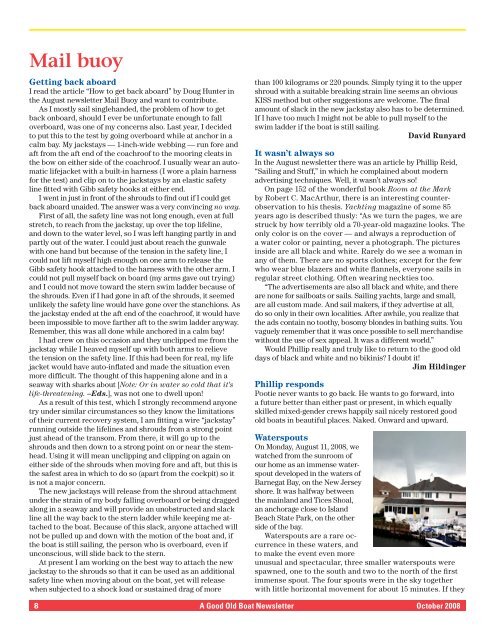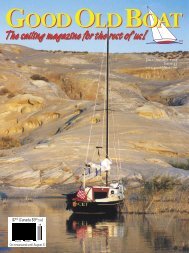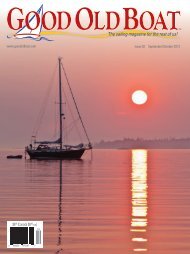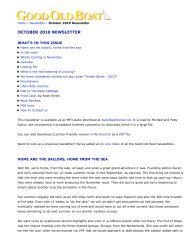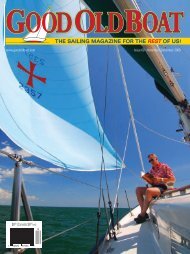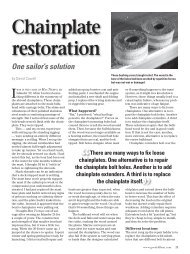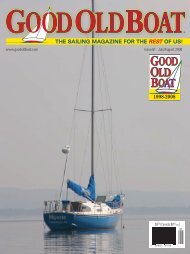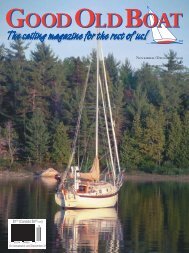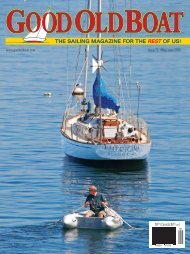PDF version - Good Old Boat Magazine
PDF version - Good Old Boat Magazine
PDF version - Good Old Boat Magazine
You also want an ePaper? Increase the reach of your titles
YUMPU automatically turns print PDFs into web optimized ePapers that Google loves.
Mail buoy<br />
Getting back aboard<br />
I read the article “How to get back aboard” by Doug Hunter in<br />
the August newsletter Mail Buoy and want to contribute.<br />
As I mostly sail singlehanded, the problem of how to get<br />
back onboard, should I ever be unfortunate enough to fall<br />
overboard, was one of my concerns also. Last year, I decided<br />
to put this to the test by going overboard while at anchor in a<br />
calm bay. My jackstays — 1-inch-wide webbing — run fore and<br />
aft from the aft end of the coachroof to the mooring cleats in<br />
the bow on either side of the coachroof. I usually wear an automatic<br />
lifejacket with a built-in harness (I wore a plain harness<br />
for the test) and clip on to the jackstays by an elastic safety<br />
line fitted with Gibb safety hooks at either end.<br />
I went in just in front of the shrouds to find out if I could get<br />
back aboard unaided. The answer was a very convincing no way.<br />
First of all, the safety line was not long enough, even at full<br />
stretch, to reach from the jackstay, up over the top lifeline,<br />
and down to the water level, so I was left hanging partly in and<br />
partly out of the water. I could just about reach the gunwale<br />
with one hand but because of the tension in the safety line, I<br />
could not lift myself high enough on one arm to release the<br />
Gibb safety hook attached to the harness with the other arm. I<br />
could not pull myself back on board (my arms gave out trying)<br />
and I could not move toward the stern swim ladder because of<br />
the shrouds. Even if I had gone in aft of the shrouds, it seemed<br />
unlikely the safety line would have gone over the stanchions. As<br />
the jackstay ended at the aft end of the coachroof, it would have<br />
been impossible to move farther aft to the swim ladder anyway.<br />
Remember, this was all done while anchored in a calm bay!<br />
I had crew on this occasion and they unclipped me from the<br />
jackstay while I heaved myself up with both arms to relieve<br />
the tension on the safety line. If this had been for real, my life<br />
jacket would have auto-inflated and made the situation even<br />
more difficult. The thought of this happening alone and in a<br />
seaway with sharks about [Note: Or in water so cold that it’s<br />
life-threatening. –Eds.], was not one to dwell upon!<br />
As a result of this test, which I strongly recommend anyone<br />
try under similar circumstances so they know the limitations<br />
of their current recovery system, I am fitting a wire “jackstay”<br />
running outside the lifelines and shrouds from a strong point<br />
just ahead of the transom. From there, it will go up to the<br />
shrouds and then down to a strong point on or near the stemhead.<br />
Using it will mean unclipping and clipping on again on<br />
either side of the shrouds when moving fore and aft, but this is<br />
the safest area in which to do so (apart from the cockpit) so it<br />
is not a major concern.<br />
The new jackstays will release from the shroud attachment<br />
under the strain of my body falling overboard or being dragged<br />
along in a seaway and will provide an unobstructed and slack<br />
line all the way back to the stern ladder while keeping me attached<br />
to the boat. Because of this slack, anyone attached will<br />
not be pulled up and down with the motion of the boat and, if<br />
the boat is still sailing, the person who is overboard, even if<br />
unconscious, will slide back to the stern.<br />
At present I am working on the best way to attach the new<br />
jackstay to the shrouds so that it can be used as an additional<br />
safety line when moving about on the boat, yet will release<br />
when subjected to a shock load or sustained drag of more<br />
than 100 kilograms or 220 pounds. Simply tying it to the upper<br />
shroud with a suitable breaking strain line seems an obvious<br />
KISS method but other suggestions are welcome. The final<br />
amount of slack in the new jackstay also has to be determined.<br />
If I have too much I might not be able to pull myself to the<br />
swim ladder if the boat is still sailing.<br />
David Runyard<br />
It wasn’t always so<br />
In the August newsletter there was an article by Phillip Reid,<br />
“Sailing and Stuff,” in which he complained about modern<br />
advertising techniques. Well, it wasn’t always so!<br />
On page 152 of the wonderful book Room at the Mark<br />
by Robert C. MacArthur, there is an interesting counterobservation<br />
to his thesis. Yachting magazine of some 85<br />
years ago is described thusly: “As we turn the pages, we are<br />
struck by how terribly old a 70-year-old magazine looks. The<br />
only color is on the cover — and always a reproduction of<br />
a water color or painting, never a photograph. The pictures<br />
inside are all black and white. Rarely do we see a woman in<br />
any of them. There are no sports clothes; except for the few<br />
who wear blue blazers and white flannels, everyone sails in<br />
regular street clothing. Often wearing neckties too.<br />
“The advertisements are also all black and white, and there<br />
are none for sailboats or sails. Sailing yachts, large and small,<br />
are all custom made. And sail makers, if they advertise at all,<br />
do so only in their own localities. After awhile, you realize that<br />
the ads contain no toothy, bosomy blondes in bathing suits. You<br />
vaguely remember that it was once possible to sell merchandise<br />
without the use of sex appeal. It was a different world.”<br />
Would Phillip really and truly like to return to the good old<br />
days of black and white and no bikinis? I doubt it!<br />
Jim Hildinger<br />
Phillip responds<br />
Pootie never wants to go back. He wants to go forward, into<br />
a future better than either past or present, in which equally<br />
skilled mixed-gender crews happily sail nicely restored good<br />
old boats in beautiful places. Naked. Onward and upward.<br />
Waterspouts<br />
On Monday, August 11, 2008, we<br />
watched from the sunroom of<br />
our home as an immense waterspout<br />
developed in the waters of<br />
Barnegat Bay, on the New Jersey<br />
shore. It was halfway between<br />
the mainland and Tices Shoal,<br />
an anchorage close to Island<br />
Beach State Park, on the other<br />
side of the bay.<br />
Waterspouts are a rare occurrence<br />
in these waters, and<br />
to make the event even more<br />
unusual and spectacular, three smaller waterspouts were<br />
spawned, one to the south and two to the north of the first<br />
immense spout. The four spouts were in the sky together<br />
with little horizontal movement for about 15 minutes. If they<br />
8 A <strong>Good</strong> <strong>Old</strong> <strong>Boat</strong> Newsletter October 2008


